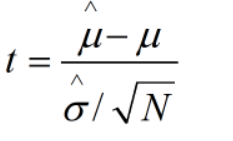正态分布
概率密度

实现以均值为4、方差为0.64,随机变量为3计算概率密度:
# 用于数值计算的库
import numpy as np
import pandas as pd
import scipy as sp
from scipy import stats
# 用于绘图的库
from matplotlib import pyplot as plt
import seaborn as sns
sns.set()
# 设置浮点数打印精度
%precision 3
# 在 Jupyter Notebook 里显示图形
%matplotlib inline
# 均值为 4 标准差为 0.8 的正态分布在随机变量为 3 时的概率密度
x = 3
mu = 4
sigma = 0.8
1 / (sp.sqrt(2 * sp.pi * sigma**2)) * \
sp.exp(- ((x - mu)**2) / (2 * sigma**2))
#0.22831135673627742
也可以使用scipy.stats.norm.pdf()函数
stats.norm.pdf(loc = 4, scale = 0.8, x = 3)
#0.228
norm_dist = stats.norm(loc = 4, scale = 0.8)
norm_dist.pdf(x = 3)
#0.228
绘制图像
x_plot = np.arange(start = 1, stop = 7.1, step = 0.1)
plt.plot(
x_plot,
stats.norm.pdf(x = x_plot, loc = 4, scale = 0.8),
color = 'black'
)

样本小于某值的比例
就是求小于等于这个值的数据个数和样本容量的比值
np.random.seed(1)
simulated_sample = stats.norm.rvs(
loc = 4, scale = 0.8, size = 100000)
simulated_sample
#array([ 5.299, 3.511, 3.577, ..., 4.065, 4.275, 3.402])
sp.sum(simulated_sample <= 3)
#10371
sp.sum(simulated_sample <= 3) / len(simulated_sample)
#0.104
stats.norm.rvs函数生成随机数的过程却是从无限总体中进行抽样。要想基于有限总体,就需要进行有限总体校正。
累积分布函数
对于随机变量X,当x为是实数时,F(X)叫做累积分布函数,也叫分布函数

求正态分布中随机变量小于等于3的概率:

累积分布函数
stats.norm.cdf 累积分布函数。
stats.norm.cdf(loc = 4, scale = 0.8, x = 4)
#0.500
左侧概率与百分位数
数据小于等于某个值的概率就叫做左侧概率。通过累积分布函数等到。
百分位数位能得到某个概率的那个值叫做百分位数。
平均值
stats.norm.pdf正态分布概率密度函数。
stats.norm.ppf()计算百分位数
stats.norm.cdf() 累积分布函数。
stats.norm.ppf(loc = 4, scale = 0.8, q = 0.025)
#2.432
二者关系
left = stats.norm.cdf(loc = 4, scale = 0.8, x = 3)
#x=3求变量小于等于3的概率
stats.norm.ppf(loc = 4, scale = 0.8, q = left)
#3.000
stats.norm.ppf(loc = 4, scale = 0.8, q = 0.5)
#4.000
标准正态分布
均值为0,方差为1的正态分布叫做标准正态分布。
t值
统计量的计算方法:

 为样本均值,μ为总体均值,σ为实际样本的无偏差标准差,N为样本容量
为样本均值,μ为总体均值,σ为实际样本的无偏差标准差,N为样本容量
文字描述为t值 = 样本均值-总体均值/标准误差
t值的样本分布
# 随机数种子
np.random.seed(1)
# 存放 t 值的空间
t_value_array = np.zeros(10000)
# 实例化一个正态分布
#均值为4,标准差为0.8
norm_dist = stats.norm(loc = 4, scale = 0.8)
# 开始实验
for i in range(0, 10000):
sample = norm_dist.rvs(size = 10)
sample_mean = sp.mean(sample)
#求样本的标准误差
sample_std = sp.std(sample, ddof = 1)
sample_se = sample_std / sp.sqrt(len(sample))
t_value_array[i] = (sample_mean - 4) / sample_se
绘制直方图
# t 值的直方图
sns.distplot(t_value_array, color = 'black')
# 标准正态分布的概率祺
x = np.arange(start = -8, stop = 8.1, step = 0.1)
plt.plot(x, stats.norm.pdf(x = x),
color = 'black', linestyle = 'dotted')

t分布
当总体服从正态分布时,t值得样本分布就是t分布
样本容量为N,N-1为自由度
t分布的图形与自由度有关,如果自由度为n,则t分布表示为t(n)
t分布的均差为0,t分布得均差稍大于1.
t(n)的方差=n/n-2
t分布的概率密度函数和标准正太分布的概率密度显示在同一张图上
iplt.plot(x, stats.norm.pdf(x = x),
color = 'black', linestyle = 'dotted')
plt.plot(x, stats.t.pdf(x = x, df = 9),
color = 'black')

3-2-10实现协方差矩阵
使用numpy的cov函数可以便捷地计算协方差矩阵
print(np.cov(x,y,ddof=0))
#[[ 3.2816 6.906 ]
# [ 6.906 25.21 ]]
#通过指定ddof=1,可以计算分母为N-1地协方差矩阵
print(np.cov(x,y,ddof=1))
# [[ 3.64622222 7.67333333]
# [ 7.67333333 28.01111111]]
t分布的意义就是在总体方差位置时也可以研究样本均值的分布
参考资料
[日] 马场真哉 著, 吴昊天 译. 用Python动手学统计学[M]. 1. 人民邮电出版社, 2021-06-01.
菜鸟网站python3






















 1242
1242











 被折叠的 条评论
为什么被折叠?
被折叠的 条评论
为什么被折叠?








